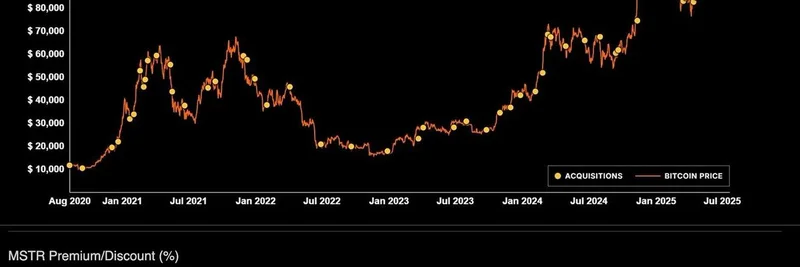In the ever-evolving world of crypto, where bubbles inflate and pop with alarming regularity, a recent discussion on X has caught the attention of blockchain enthusiasts and meme token aficionados alike. It all started with a detailed analysis from Joseph (@JosephA140), a former Citi Research Crypto Lead, who argues that Digital Asset Treasuries (DATs) – think MicroStrategy's Bitcoin hoarding strategy – might not be the golden ticket everyone thinks they are. Then, Matty Tay (@mattytay), co-founder of Colosseum and a Solana alum, chimed in with a thought-provoking response: short-term pumps via DATs versus long-term revolution through cypherpunk products. Let's break this down, especially how it ties into the wild world of meme tokens.
Understanding DATs and the Bubble Cycle
First off, what's a DAT? Simply put, Digital Asset Treasuries are traditional companies that raise money by selling shares and then use those funds to buy up cryptocurrencies like Bitcoin or Ethereum. The poster child here is MicroStrategy, led by Michael Saylor, which has amassed over 630,000 BTC since 2020. Joseph explains that these entities trade on something called mNAV (market Net Asset Value), which can be at a premium or discount to their actual holdings.
Joseph draws parallels to past crypto bubbles: the 2017 ICO frenzy and the 2021 algorithmic stablecoin debacle with Luna and FTX. He sees DATs as the latest "new paradigm" that's more hype than substance. The key mechanism is a reflexive flywheel: when shares trade at a premium, the company can issue more equity to buy more crypto, driving up prices and attracting more investors. But when that premium flips to a discount – as it did during tighter liquidity in 2022/2023 – things can unravel fast.
Look at this chart from Joseph's post: It shows how MicroStrategy's acquisitions (yellow dots) align with Bitcoin's price surges (orange line), while the premium/discount (green/red line) has mostly stayed positive but is showing signs of divergence recently. Joseph predicts this could be a turning point, especially as more DATs flood the market.
He argues DATs should actually trade at deep discounts because they lack ways to return value to shareholders – no dividends, no redemptions, just holding assets forever. This makes them akin to closed-end funds like Grayscale's Bitcoin Trust (GBTC), which crashed to a 50% discount in 2022 when confidence waned.
The Risks: Debt, Regulation, and Meme Token Implications
Joseph doesn't see forced liquidations from debt as the main threat – MicroStrategy's $8.2 billion in debt is dwarfed by its holdings, needing BTC to drop to $13,000 for real trouble. Instead, he foresees discounts leading to investor lawsuits, regulatory crackdowns, or activist takeovers forcing asset sales.
And here's where it gets juicy for meme token fans: Joseph predicts more DATs launching for speculative assets like Pepe, Bonk, and even Fartcoin. This could signal the peak of the liquidity cycle, pumping prices short-term but setting up for a nasty unwind. Imagine a company raising equity to buy boatloads of meme coins – exciting at first, but if premiums vanish, those holdings could flood back into the market, crashing prices.
He lists potential headlines: DATs trading at discounts within 12 months, lawsuits against MicroStrategy, sentiment shifting from "alchemy" to "predatory," and activists forcing liquidations. For meme tokens, this means volatility ahead – great for traders, but a reminder that hype vehicles like DATs aren't sustainable.
Matty Tay's Counter: Build for the Long Haul
Enter Matty Tay, who quotes Joseph's thread and flips the script: "Ya you could pump the coins in the short run by launching more DATs. Or you could pump the coins forever by building a cypherpunk product that revolutionizes capital markets in the 21st century."
Cypherpunk? It's a nod to the crypto OG philosophy of using cryptography for privacy and freedom, like Bitcoin's roots. Matty, with his Solana background, is likely hinting at projects that innovate on-chain, perhaps through decentralized finance (DeFi) or new protocols that make capital markets more efficient and accessible.
This resonates deeply in the meme token space, where many projects start as jokes but evolve (or die) based on community and utility. Instead of relying on corporate treasuries to artificially inflate prices, why not build something groundbreaking? Think Solana's high-speed blockchain enabling meme coin launches that go viral, or tools that empower users to create real value.
What This Means for Blockchain Practitioners and Meme Enthusiasts
As someone who's navigated the highs and lows of crypto journalism, I see this debate as a wake-up call. DATs might provide liquidity boosts, but they're vulnerable to market shifts and regulatory eyes – remember the SEC's past rulings on investment companies? For meme tokens like Pepe and Bonk, DATs could mean short-term gains but long-term pain if the bubble bursts.
The real path forward? Innovation. Projects that embody cypherpunk ideals – secure, decentralized, revolutionary – could sustain pumps indefinitely by attracting genuine adoption. If you're a blockchain practitioner, focus on building products that solve real problems in capital markets, like frictionless trading or privacy-preserving transactions.
Check out the original thread on X for the full scoop. What's your take – DATs for the win, or time to go cypherpunk? Drop your thoughts in the comments!



